We may earn a commission when you purchase through affiliate links. Learn more.
A land of incredible natural diversity, the landscape of New Mexico ranges from towering forested peaks to high plains; vast, ancient lava fields; and wide desert spaces. One of the most spectacular wonders in this state filled with so many exceptional natural views is White Sands National Park.
Part of the world’s largest gypsum dune field, White Sands National Park is breathtaking to behold, and is easily one of New Mexico’s most photogenic areas, drawing landscape and nature photographers from around the world.
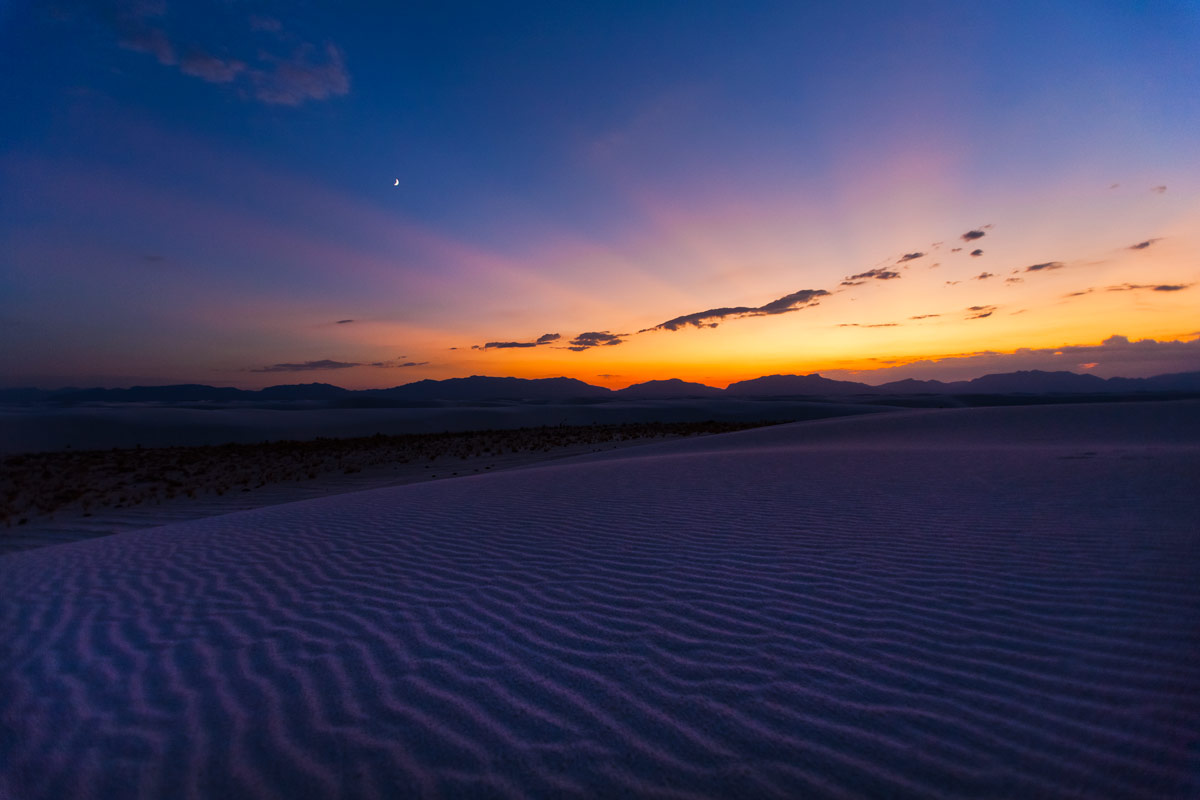
White Sands National Park
Park History
The human history of the Tularosa Basin area where White Sands is located stretches back more than ten thousand years, perhaps even earlier than when the majority of the dune field began to form. While it is difficult for geologists to determine precisely, it’s believed that the dunes began to build approximately 6500-7000 years ago.
Between 200 CE and about 1400 CE, the area was inhabited by the Jornada Mogollon, an indigenous culture whose range stretched from Northern Sonora and Chihuahua in modern day Mexico to Western Texas and southern Arizona and New Mexico. Today’s modern Hopi, Acoma, and Zuni peoples consider themselves to be the descendents of the Mogollon.
In 1933, President Herbert Hoover created White Sands National Park, protecting 143,733 acres of land, including 115 square miles of the area’s 275 square mile dune field. The 60% of the dune field which is not located within the Park lies on military land, where weapons testing has been conducted for decades.
White Sands National Park Flora & Fauna
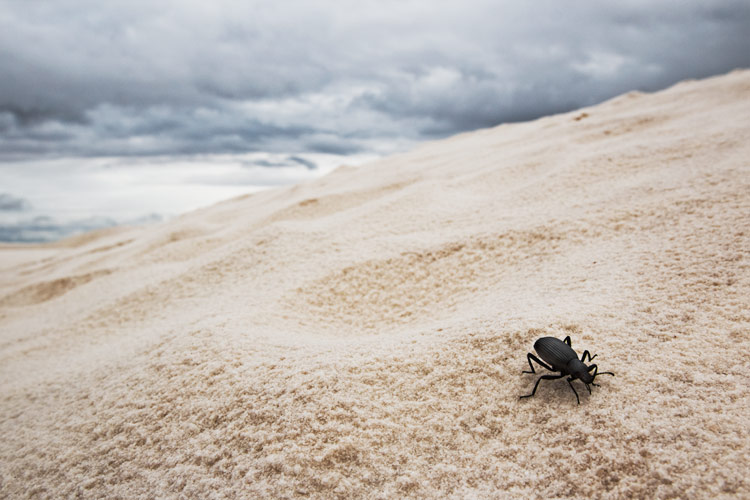 Gypsum sand dunes make for a tough place for plants and animals to survive, but amazingly many are able to thrive in this environment. Of particular interest to the macro photographers, more than 500 invertebrate species such as beetles and spiders can be found within the park. For those with keen eyes and long lenses, more than 200 species of birds have been spotted, including the fascinating roadrunner which can run at speeds of 20 mph.
Gypsum sand dunes make for a tough place for plants and animals to survive, but amazingly many are able to thrive in this environment. Of particular interest to the macro photographers, more than 500 invertebrate species such as beetles and spiders can be found within the park. For those with keen eyes and long lenses, more than 200 species of birds have been spotted, including the fascinating roadrunner which can run at speeds of 20 mph.
More than 30 reptile species dwell in the park, including the Prairie Rattlesnake and Western Diamondback Rattlesnake. Although they’re unlikely to be spotted during the day, extra care should be taken when walking through interdune areas filled with scrub.
Mammal species in the Park number over 50, but most — like coyotes and bobcats live on the outskirts of the dunes and venture in after dark to feed. Some mammals do live in the dune field itself though, including the kit fox, kangaroo rat, and pocket mouse.
Plants are essential to the landscape and ecosystem of White Sands National Park. Beyond just providing shelter and food for the animals who dwell within the park, the plants and their root systems help to stabilize the dunes. One of the most visible and iconic plant species found in the dunes is the soaptree yucca, which can grow to over 12 feet in height. As the dunes shift and the sand rises, the stem of the soaptree yucca grows higher, enabling the plant to stay above the dunes.
Camping in White Sands National Park
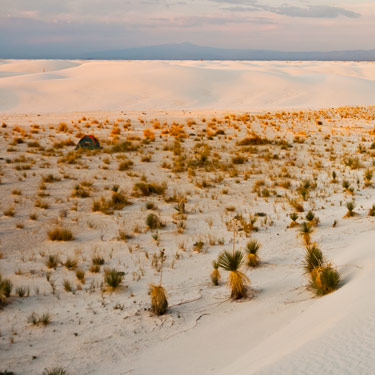 White Sands National Park does not have a developed campground, but there are 10 primitive backcountry campsites available on a first come first serve basis for backpackers. These backcountry campsites are especially popular with photographers, since camping in the park enables photographers to wake up early before the park gates open to capture the beautiful sunrise over the dunes. While the park is typically open until shortly after sunset, camping at one of these backcountry sites allows for a more leisurely sunset photography session without needing to worry about exiting the park by a designated time.
White Sands National Park does not have a developed campground, but there are 10 primitive backcountry campsites available on a first come first serve basis for backpackers. These backcountry campsites are especially popular with photographers, since camping in the park enables photographers to wake up early before the park gates open to capture the beautiful sunrise over the dunes. While the park is typically open until shortly after sunset, camping at one of these backcountry sites allows for a more leisurely sunset photography session without needing to worry about exiting the park by a designated time.
A two mile loop trail leads to and from the campsites, the first of which is located 3/4 of a mile from the trailhead. Because the trail leads through the dunes, bringing excessively heavy gear is not recommended since it can be a tough trek with a heavy backpack. Keep in mind that nighttime temperatures can fall from 30-60 degrees at night, making warm sleeping bags a necessity even during the summer months. Early morning temperatures quickly rise with the sun, and it’s recommended that backpackers bring at least one gallon of water per person, per day.
Camping permits are available at the park visitor center until one hour before sunset, and all hikers must be at their campsite and set up by dark. You can learn more about backcountry camping in White Sands National Park here.
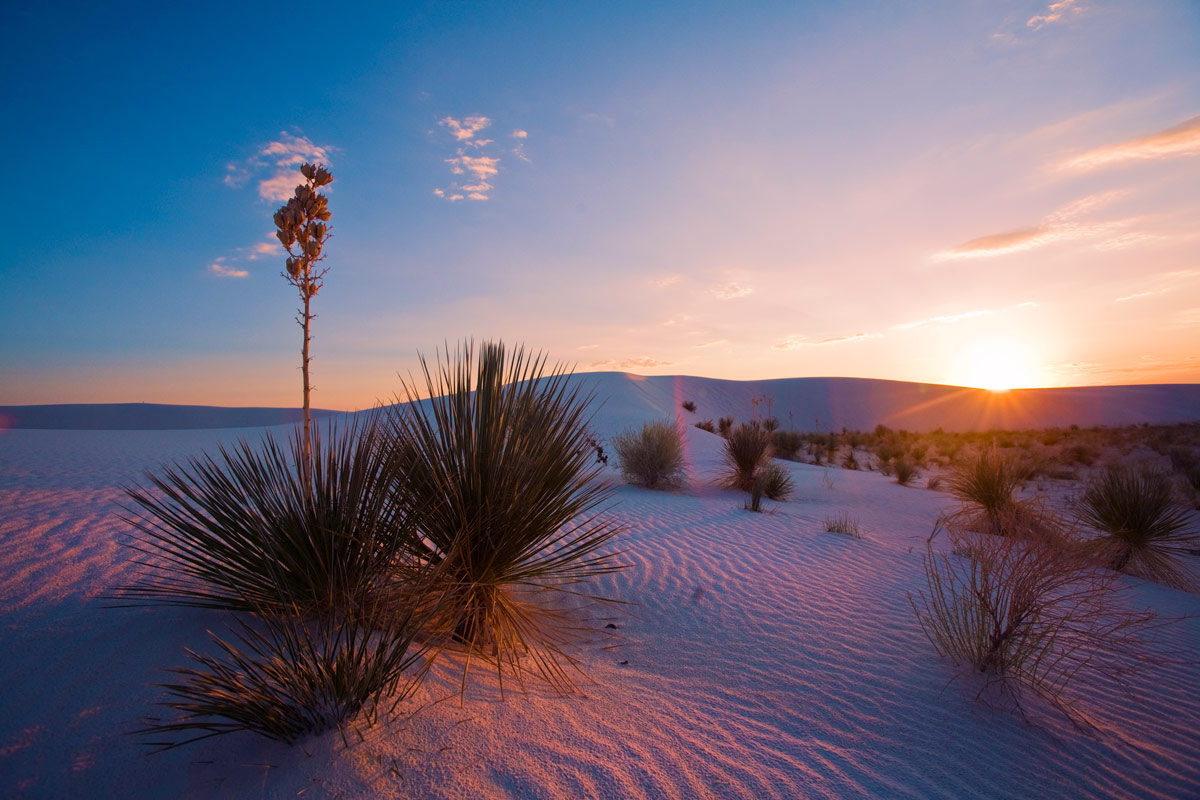
Where to Go & What to Photograph
White Sands National Park is home to five trails and numerous pull-off areas along Dunes Drive, the 8 mile road into the park. The further into the dune field you drive, the more sparse the vegetation becomes; for wide angle photos of the vast sea of gypsum sand, you’ll find the Alkali Flat and Backcountry Loop trails offer some of the best vistas in the park.
While the wind blown dunes with their textured ripples make for striking photography subjects, don’t overlook the details at White Sands National Park. Colorful wildflowers, unique insects, and even animals like rabbits, snakes, and lizards can be spotted if you’re observant and patient.
Interdune Boardwalk
At slightly over 1/3 of a mile in length, this raised boardwalk is completely wheelchair and stroller accessible, making it the easiest trail in the park. The boardwalk passes through the interdune areas and during certain seasons you may see colorful wildflowers. Most of the surrounding dunes along the trail are dotted with vegetation, so if it’s pure white sand dunes that you’re hoping to photograph, this trail may not be for you.
Dune Life Nature Trail
The Dune Life Nature Trail is a relatively easy one mile loop trail that takes hikers along the edge of the dunes where they are most likely to encounter interesting plant and animal life. Photographers on this trail will find the early morning and late afternoon to be the best times for encountering wildlife in the area — during the heat of the day, you’re unlikely to see many animals.
Playa Trail
The Playa Trail is a very short (less than 1/3 mile round trip) and easy walk over level ground leading to a low area known as a playa where rainwater collects. During much of the year, there is no water present, but if you happen to visit during the rainy season or shortly after a rainstorm, this is an excellent area to photograph wildlife in.
Backcountry Loop
2.2 miles roundtrip, the Backcountry Loop is typically hiked by backpackers heading to one of the ten backcountry campsites located along this trail. It is moderately difficult, especially during the heat of the day, and passes up and down several dunes. Many of the dunes along this trail are free of vegetation, making them perfect for photographers hoping to capture scenic shots of the wide open dune field with the San Andres Mountains in the background.
Alkali Flat Trail
A 4.6 mile roundtrip loop trail, the Alkali Flat trail is the longest and most difficult in the park, passing up and down numerous steep dunes, most of them devoid of vegetation. In the summer heat this is a difficult hike, especially if you’re carrying heavy camera equipment and a tripod, so you’ll want to keep your load as light as possible and ensure that you have plenty of water.
This trail offers some of the best views of the otherworldly dune landscape — remember, you don’t have to hike the entire trail to capture some amazing photos.
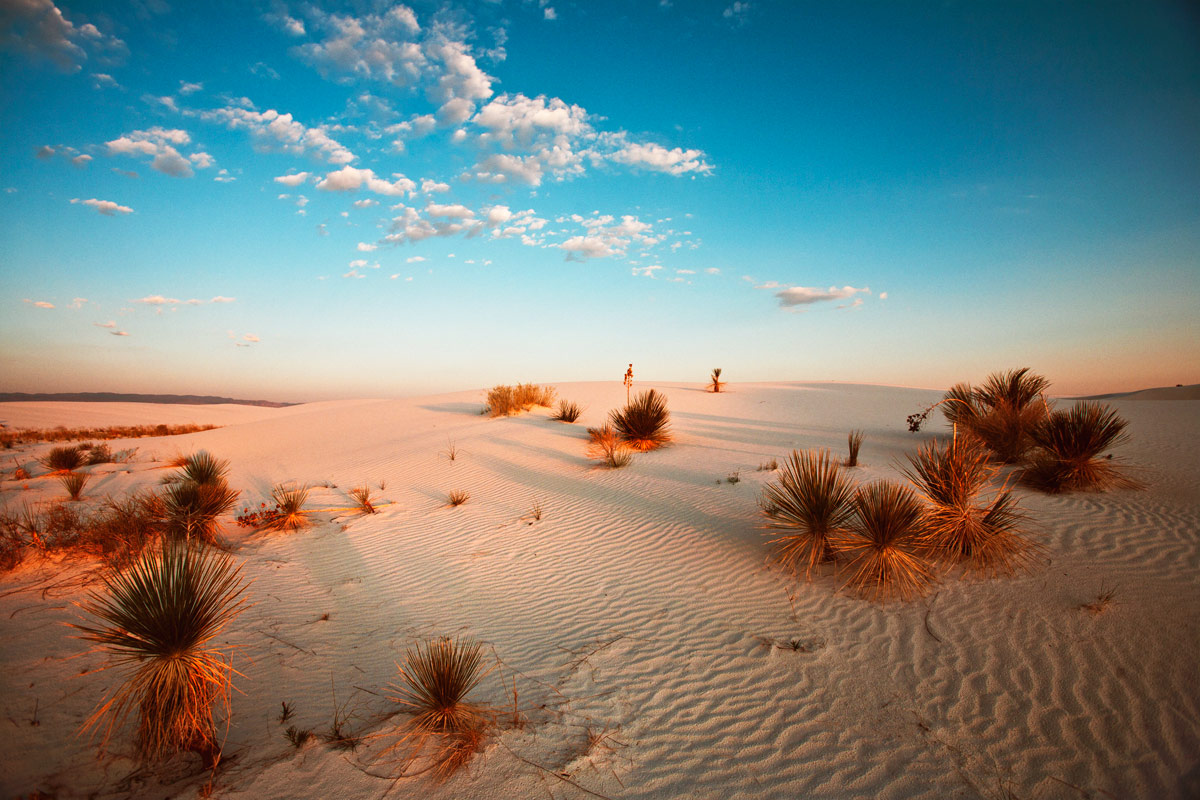
Recommended Photography Equipment
Unlike in some environments like damp tropical rainforests and freezing Arctic ice floes, you won’t need much in the way of specialized photography gear to shoot at White Sands National Park. To help you plan for your trip though, here’s a list of some of the basic items which will help make your photography adventure in the dunes a success!
Camera with Manual Exposure Control
While you can certainly take photos with just a cell phone or point and shoot camera, photography at White Sands National Park poses a few challenges — frequent sunny days, and very reflective white gypsum sand. Automatic exposure decisions by many cameras results in overexposed sand, so being able to check your camera’s histogram and make manual exposure adjustments can really help you capture properly exposed images, even during the middle of the day. When most people think of manual controls, they think of DSLR and mirrorless cameras, but don’t overlook the capabilities of smaller advanced compact cameras like the Ricoh GR II, Sony RX100 IV, and Fuji X30 which all offer manual exposure control.
An Umbrella
Rain or shine, an umbrella will come in handy when you’re photographing at White Sands National Park. During one of the frequent rainstorms in summer and early fall, the use of an umbrella is obvious, but you might be wondering why you’d want one during a sunny day.
In a blindingly white sea of sand, you’ll find that on sunny days an umbrella provides a very welcome circle of shade, making it much easier to see the LCD screen on your camera. In bright sunlight, without the aid of an umbrella, seeing what’s on your camera screen can be nearly impossible.
If you’re headed to the park during the rainy season, you may also find it useful to bring along a rain cover for your camera such as the Vortex Media Pro Storm Rain Cover which gives you access to your camera controls even when tripod mounted. You can find plenty of tips for photography in rainy conditions in this guide and tips on rain protection gear in this one.
Polarizing Filter
Adding a polarizing filter to your lens can help to improve contrast in your shot, darken the sky, improve the color saturation, and cut the glare of the sun against reflective surfaces like water that often collects in the flat areas between dunes.
Circular polarizing filters come in different filter thread sizes, so double check what size of filter you’ll need for your lenses. You’ll need to rotate the filter on your lens until you obtain the desired effect.
Photography Tips for Shooting at White Sands National Park
 1. Arrive Early
1. Arrive Early
If you’re hoping to see any wildlife in the park, you’ll need to arrive early in the morning. Most animals that can be found in and around the dunes retreat out of sight as the day heats up.
Dunes Drive opens at 7am, 364 days a year (the park is closed on Christmas day). Since sunrise often occurs before 7am depending upon the time of year, photographers have two options to be in the park before 7am. The first option is to backcountry camp at one of the ten campsites — this option is ideal especially if you want to keep shooting after sunset and hope to shoot star photography at night.
The second option is to obtain a permit to enter earlier or stay later in the park. As of 2015, the fee is $50 per hour for every hour that the park will open early or close late for. That means if you want to photograph a 6:15am sunrise, and want to be in the dunes by 5:45am, you’d need to pay $100. You can learn more about the process and download the application forms here.
2. Find Pristine Dunes
You’ll find that the gypsum sand dunes closest to pullouts along the road and near the trails tend to be covered in footprints. A solitary path of footprints can make for an interesting composition, but a dune that is completely covered in footprints doesn’t make for a very appealing shot. Look for dunes that haven’t been walked on, but do you best not to cover a pristine dune with your own tracks.
3. Shoot RAW
While images shot in JPEG can look great, the tricky lighting conditions of White Sands National Park make RAW the obvious choice for most photographers. Shooting in RAW offers a great deal of flexibility when processing the image later, and is much more forgiving if you’ve slightly over or underexposed an image.
4. Check your Histogram
Your camera’s histogram charts the distribution of tones in your image, from dark black shadows on the very left to bright white highlight on the far right, with midtones in the center. This is an especially useful feature, because it can be very difficult to see your camera’s LCD screen to visually evaluate the exposure during the day while shooting at White Sands. When you see a high spike somewhere on the histogram, that tells you that there are a lot of pixels of that particular tone. If the spike is pressed against the right edge of the histogram, this can tell you that you’ve got overexposed areas in your image.
4. Give Black & White a Shot
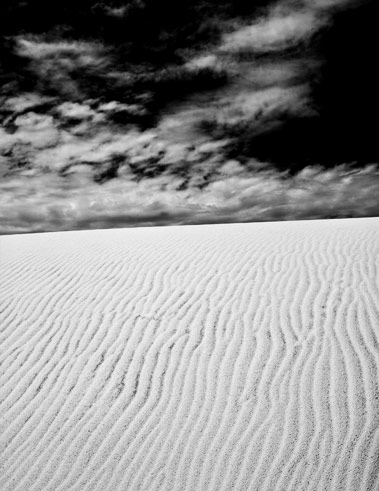 Some locations seem to look best when photographed in color, while others shine in black and white. White Sands National Park is one of those places which looks good when photographed in both color and black and white, making for some tough decisions when processing digital photos. Dark blue skies and bright white dunes with ripples that cast deep shadows make for perfect conditions to give black and white a try.
Some locations seem to look best when photographed in color, while others shine in black and white. White Sands National Park is one of those places which looks good when photographed in both color and black and white, making for some tough decisions when processing digital photos. Dark blue skies and bright white dunes with ripples that cast deep shadows make for perfect conditions to give black and white a try.
5. Search for Texture and Details
Crouch down and capture the amazing texture of the gypsum sand. Like the surface of the ocean, the dunes are covered in ripples of sand, caused by wind action. Take careful note of where the light is coming from so that you can clearly see these ripples in your photos.
6. Capture the Golden Hour
Shortly after sunrise and before sunset, the golden hour is beloved by photographers. During this time of day the sun is low in the sky and casts a warm, golden glow across the landscape. While the harsh light of midday can create long shadows, the light during the golden hour is soft and accentuates the beautiful colors of New Mexico’s high desert landscape.

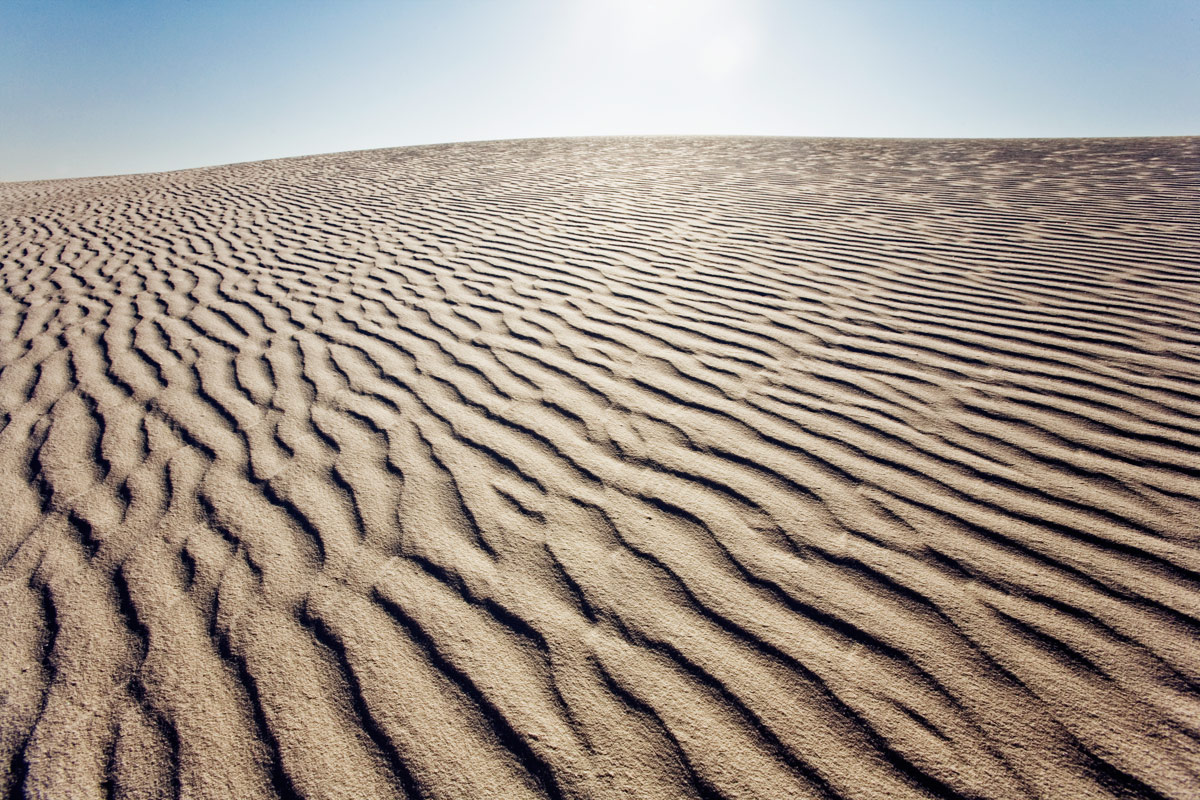
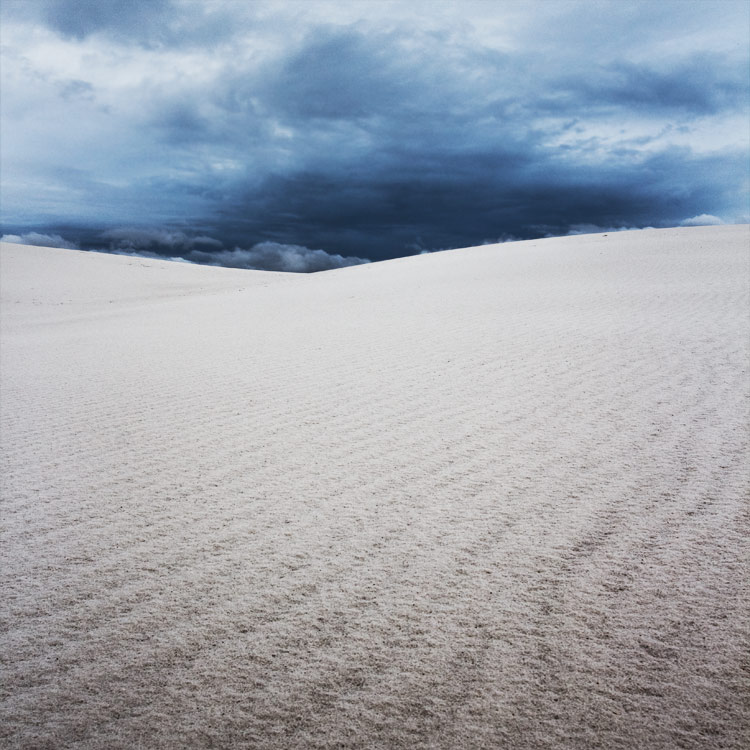 1. Arrive Early
1. Arrive Early